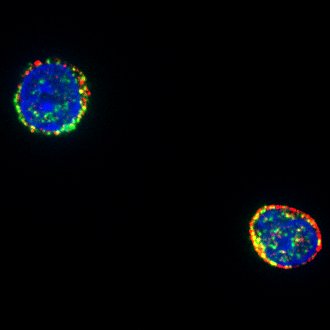Discovery of a novel, advanced technique to identify the rare cells where human immunodeficiency virus (HIV) hides in patients taking antiretroviral therapy (ART). This is an important step forward in the search for a HIV/AIDS cure.
[adsense:336x280:8701650588]
Why wake up the virus? To better kill it, of course. A team from the University of Montreal Hospital Research Centre (CRCHUM) has taken an important step forward in the search for a HIV/AIDS cure. The laboratory of Dr. Daniel Kaufmann has developed a highly accurate technique for detecting the rare cells that hide the virus and prevent current therapies from curing HIV infection.
"We can wake up the virus and then find the rare cells that have been hiding it at very low numbers, a limit of one cell in a million. This is an unprecedented level of accuracy, which opens the door to individualized monitoring of HIV-positive patients and could facilitate the development of personalized treatments," said Dr. Kaufmann, senior author of a study on the subject published in a featured article in the current issue of Cell Host & Microbe.
HIV reservoirs are cells and tissues in which the virus persists despite ART. The virus predominantly lives and replicates in a particular type of white blood cell, CD4+ T lymphocytes. While antiretroviral drugs are generally successful in controlling the viral load in infected individuals, preventing the progression to acquired immunodeficiency syndrome (AIDS), some viruses remain hidden for years and can be reactivated if patients stop their treatment.
"CD4+ T lymphocyte populations are highly variable. To develop new, targeted treatments to eliminate these residual infected cells, we need to find exactly where in the CD4 T lymphocyte population the virus hides. Our research has uncovered these HIV hiding places. We were able to identify and quantify the cells containing hidden virus and then test drugs to wake up HIV,” said Kaufmann, who is a researcher and infectious disease specialist at the University of Montreal Hospital Centre (CHUM).
His team has developed an innovative technique for detecting these reservoirs – a way of taking a “photo” of each individual cell hiding the virus – a significant breakthrough, as this approach is 1,000 times more accurate than current technologies. Once the HIV hiding places are found, the researchers can use a “shock and kill” strategy to eliminate the virus in two stages. Firstly, the HIV must be woken up from its dormant state in the cells. The virus then becomes visible to the immune system or drugs that can eliminate it.

T cells from a HIV-infected patient were stained for HIV RNA (red), HIV protein (green) and the nucleus (blue) and analyzed by microscopy. This approach allows researchers to analyze very rare HIV-infected cells from humans in unprecedented detail. Credit: Dr. Daniel Kaufmann laboratory, CRCHUM.
Professor Kaufmann’s team analyzed the blood of 30 patients infected with HIV, both before patients started treatment and after they received ART. “We were able to detect the virus in CD4+ T lymphocytes in almost all of the patients we analyzed,” said Amy Baxter, a postdoctoral fellow at the CRCHUM and first author of the study.
The researchers then tested two so-called latency reversal drugs: bryostatin and a derivative of ingenol. These drugs were developed to fight cancer, but might also be used against HIV. "While our studies were conducted in the laboratory, a clinical trial would involve using such drugs to wake up the virus while the patient continues taking ART to ensure that the reactivated virus can not infect other cells,” explained Dr. Kaufmann.
“In the laboratory we found that the two drugs wake up different populations of CD4+ T lymphocytes, thus waking up different reservoirs. The ingenol derivative activates a population called central memory cells. These cells can live for years in patients, all the while hiding the virus. Therefore, it is particularly important to target these reservoirs,” noted Baxter.
At first sight it appears as though the virus hides in similar places in different patients. However, Dr. Kaufmann’s team has revealed that there is also large variability from one patient to another. “We may have to adjust the treatment for individual patients, depending on the specific HIV hiding places in each case. To minimize the virus pools, we will have to assess patients and tailor the “shock and kill” therapies to their profiles,” said Dr. Kaufmann.
Before arriving at a potential treatment for humans, the researchers are planning to evaluate the effectiveness of new drugs to awaken similar virus reservoirs in monkeys and determine where the virus is hidden. If the drugs are well tolerated, clinical trials will begin in a few years. After 30 years of research to cure HIV infection and AIDS, this opens a whole new avenue in understanding how scientists could track and find infected cells, then wake up and kill the virus hiding deep inside.







